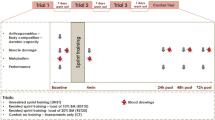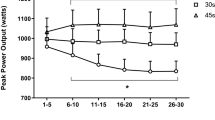Abstract
The effects of active recovery on metabolic and cardiorespiratory responses and power output were examined during repeated sprints. Male subjects (n = 13) performed two maximal 30-s cycle ergometer sprints, 4 min apart, on two separate occasions with either an active [cycling at 40 (1)% of maximal oxygen uptake; mean (SEM)] or passive recovery. Active recovery resulted in a significantly higher mean power output (\(\bar W\)) during sprint 2, compared with passive recovery [\(\bar W\)] 603 (17) W and 589 (15) W, P < 0.05]. This improvement was totally attributed to a 3.1 (1.0)% higher power generation during the initial 10 s of sprint 2 following the active recovery (P < 0.05), since power output during the last 20 s sprint 2 was the same after both recoveries. Despite the higher power output during sprint 2 after active recovery, no differences were observed between conditions in venous blood lactate and pH, but peak plasma ammonia was significantly higher in the active recovery condition [205 (23) vs 170 (20) μmol · 1−1;P < 0.05]. No differences were found between active and passive recovery in terms of changes in plasma volume or arterial blood pressure throughout the test. However, heart rate between the two 30-s sprints and oxygen uptake during the second sprint were higher for the active compared with passive recovery [148 (3) vs 130 (4) beats · min−1;P < 0.01) and 3.3 (0.1) vs 2.8 (0.1) 1 · min−1;P < 0.01]. These data suggest that recovery of power output during repeated sprint exercise is enhanced when low-intensity exercise is performed between sprints. The beneficial effects of an active recovery are possibly mediated by an increased blood flow to the previously exercised muscle.
Similar content being viewed by others
References
Allsop P, Cheetham M, Brooks S, Hall GM, Williams C (1990) Continuous intramuscular pH measurement during the recovery from brief, maximal exercise in man. Eur J Appl Physiol 59:465–470
Bogdanis GC, Nevill ME, Lakomy HKA, Boobis LH (1994) Muscle metabolism during repeated sprint exercise in man. J Physiol (Lond) 475:25P
Bogdanis GC, Nevill ME, Boobis LH, Lakomy HKA, Nevill AM (1995) Recovery of power output and muscle metabolites following 30 s of maximal sprint cycling in man. J Physiol (Lond) 482:467–480
Dill DB, Costill DL (1974) Calculation of percentage changes in volumes of blood, plasma and red cells in dehydration. J Appl Physiol 37:247–248
Dodd S, Powers SK, Callender T, Brooks E (1984) Blood lactate disappearance at various intensities of recovery exercise. J Appl Physiol 57:1462–1465
Gaitanos GC (1990) Human muscle metabolism during intermittent maximal exercise. PhD Thesis, Loughborough University of Technology
Gladden LB (1989) Lactate uptake by skeletal muscle. In: Pandolf K (ed) Exercise and Sport Science Reviews, vol 17. Williams and Wilkins, Baltimore, pp 115–155
Gladden LB (1991) Net lactate uptake during progressive steady level contractions in canine skeletal muscle. J Appl Physiol 71:514–520
Harris RC, Hultman E, Kaijser L, Nordesjo LO (1975) The effect of circulatory occlusion on isometric exercise capacity and energy metabolism of the quadriceps muscle in man. Scand J Clin Lab Invest 35:87–95
Harris RC, Edwards RHT, Hultman E, Nordesjo LO, Nylind B, Sahlin K (1976) The time course of phosphorylcreatine resynthesis during recovery of the quadriceps muscle in man. Pflugers Arch 367:137–142
Hildebrandt W, Schutze H, Stegemann J (1992) Cardiovascular limitations of active recovery from strenuous exercise. Eur J Appl Physiol 64:250–257
Kowalchuk JM, Heigenhauser GJF, Lindinger MI, Sutton JR, Jones NL (1988a) Factors influencing hydrogen ion concentration in muscle after intense exercise. J Appl Physiol 65:2080–2089
Kowalchuk JM, Heigenhauser GJF, Lindinger MI, Obminski G, Sutton JR, Jones NL (1988b) Role of lungs and inactive muscle in acid-base control after maximal exercise. J Appl Physiol 65:2090–2096
Lakomy HKA (1986) Measurement of work and power output using friction-loaded cycle ergometers. Ergonomics 29:509–517
Lindinger MI, Heigenhauser GJF, McKelvie RS, Jones NL (1990) Role of nonworking muscle blood metabolites and ions with intense intermittent exercise. Am J Physiol 258:R1486-R1494
Marlin DJ (1989) Metabolic response to high intensity exercise in the Thoroughbred horse. PhD Thesis, Loughborough University of Technology
Maughan RJ (1982) A simple, rapid method for the determination of glucose, lactate, pyruvate, alanine, 3-hydroxybutyrate and acetoacetate on a single 20 ml blood sample. Clin Chim Acta 122:231–240
Miles DS, Owens JJ, Golden JC, Gotshall RW (1987) Central and peripheral hemodynamics during maximal leg extension exercise. Eur J Appl Physiol 56:12–17
Pagliassotti MJ, Donovan CM (1990) Influence of cell heterogeneity on skeletal muscle lactate kinetics. Am J Physiol 258:E625-E634
Quistorff B, Johansen L, Sahlin K (1992) Absence of phosphocreatine resynthesis in human calf muscle during ischaemic recovery. Biochem J 291:681–686
Renaud JM (1989) The effect of lactate on intracellular pH and force recovery of fatigued sartorius muscles of the frog,pana pipiens. J Physiol (Lond) 416:31–47
Sahlin K, Harris RC, Nylind B, Hultman E (1976) Lactate content and pH in muscle samples obtained after dynamics exercise. Pflugers Arch 367:143–149
Sahlin K, Harris RC, Hultman E (1979) Resynthesis of creative phosphate in human muscle after exercise in relation to intramuscular pH and availability of oxygen. Scand J Clin Lab Invest 39:551–558
Sale DG, Moroz DE, McKelvie RS, MacDougall JD, McCartney N (1993) Comparison of blood pressure response to isokinetic and weight-lifting exercise. Eur J Appl Physiol 67:115–120
Saltin B, Bangsbo J, Graham TE, Johansen L (1992) Metabolism and performance in exhaustive intense exercise; different effects of muscle glycogen availability, previous exercise and muscle acidity. In: Marconnet P, Komi PV, Saltin B, Sejersted OM (eds) Muscle fatigue mechanisms in exercise and training. Medicine and Sport Science, vol 26. Karger, Basle, pp 98–109
Signorile JF, Ingalls C, Tremblay LM (1993) The effects of active and passive recovery on short-term, high intensity power output. Can J Appl Physiol 18:31–42
Sjogaard G (1987) Muscle fatigue. In: Marconnet P, Komi PV, Saltin B, Sejersted OM (eds) Muscular function in exercise and training. Medicine and Sport Science, vol 26. Karger, Basle, pp 98–109
Sjogaard G (1990) Exercise-induced muscle fatigue: the significance of potassium. Acta Physiol Scand 140 [Suppl 593]:1–63
Sjogaard G, Saltin B (1982) Extra- and intracellular water spaces in muscles of man at rest and with dynamic exercise. Am J Physiol 243:R271-R280
Spriet LL, Lindinger MI, McKelvie RS, Heigenhauser GJF, Jones NL (1989) Muscle glycogenolysis and H+ concentration during maximal intermittent cycling. J Appl Physiol 66:8–13
Stainsby WN, Brooks GA (1990) Control of lactic acid metabolism in contracting muscles and during exercise. In: Pandolf KB, Holloszy JO (eds) Exercise and Sport Science Reviews, vol 18. Williams and Wilkins, Baltimore, pp 29–63
Stamford BA, Weltman A, Moffatt R, Sady S (1981) Exercise recovery above and below anaerobic threshold following maximal work. J Appl Physiol 51:840–844
Stanley WC, Gertz EW, Wisneski JA, Neese RA, Morris DL, Brooks GA (1986) Lactate extraction during net lactate release in legs of humans during exercise. J Appl Physiol 60:1116–1120
Weltman A, Regan JD (1983) Prior exhaustive exercise and subsequent, maximal constant load exercise performance. Int J Sports Med 4:184–189
Weltman A, Stamford BA, Moffatt RJ, Katch VL (1977) Exercise recovery, lactate removal, and subsequent high intensity exercise performance. Res Q 48:786–796
Weltman A, Stamford BA, Fulco C (1979) Recovery from maximal effort exercise: lactate disappearance and subsequent performance. J Appl Physiol 47:677–682
Yoshida T, Watari H (1993)31P-Nuclear magnetic resonance spectroscopy study of the time course of energy metabolism during exercise and recovery. Eur J Appl Physiol 66 1:494–499
Author information
Authors and Affiliations
Rights and permissions
About this article
Cite this article
Bogdanis, G.C., Nevill, M.E., Lakomy, H.K.A. et al. Effects of active recovery on power output during repeated maximal sprint cycling. Europ. J. Appl. Physiol. 74, 461–469 (1996). https://doi.org/10.1007/BF02337727
Accepted:
Issue Date:
DOI: https://doi.org/10.1007/BF02337727




